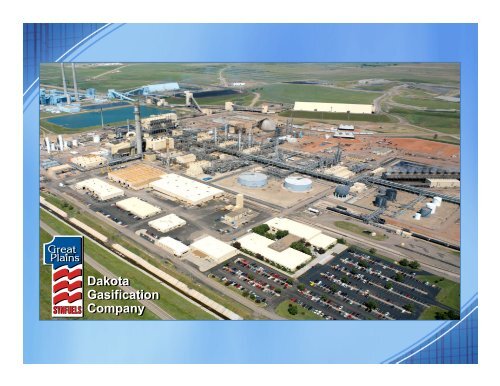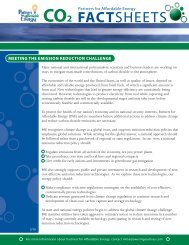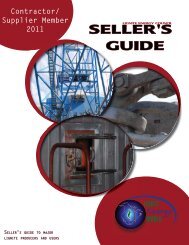Dakota Gasification Company Dakota Gasification Company
Dakota Gasification Company Dakota Gasification Company
Dakota Gasification Company Dakota Gasification Company
You also want an ePaper? Increase the reach of your titles
YUMPU automatically turns print PDFs into web optimized ePapers that Google loves.
<strong>Dakota</strong><br />
<strong>Gasification</strong><br />
<strong>Company</strong>
<strong>Dakota</strong> <strong>Gasification</strong> <strong>Company</strong>’s<br />
Great Plains Synfuels Plant (GPSP)<br />
Concept started in early 1970s<br />
GPSP built by a consortium<br />
of 5 pipeline companies<br />
Construction began in 1981<br />
Synthetic Natural Gas (SNG)<br />
production began in 1984<br />
2
A new owner….DGC<br />
A technological marvel but not a financial success…<br />
Original Owners Default<br />
The original investors defaulted on August 1, 1985, about one year<br />
after first gas was put in the pipeline, due to the very low price of<br />
natural gas.<br />
DOE Operation Period<br />
The DOE operated the plant from 1985 until 1988<br />
Sold to Basin Electric Power Cooperative<br />
Basin Electric purchased the plant from the DOE & formed DGC, a<br />
wholly owned subsidiary to operate the facility.<br />
3
DGC’s Great Plains Synfuels Plant<br />
A Unique Facility<br />
Only commercial coal gasification facility producing synthetic<br />
natural gas<br />
Byproducts sales of anhydrous ammonia, liquid nitrogen, &<br />
sulfur<br />
Diversification of products began in 1989 with initial $25 million<br />
for capital projects for phenol/cresylic acid & xenon/krypton<br />
Installation of flue gas desulfurization project to produce<br />
DakSul45 in 1996<br />
1100 ton/day Anhydrous Ammonia Plant completed in 1997<br />
Carbon Dioxide (CO 2 ) Pipeline for Enhanced Oil Recovery (EOR)<br />
in 2000<br />
4
Great Plains Synfuels Plant<br />
Process Flow<br />
SYNTHESIS GAS<br />
OXYGEN<br />
PLANT<br />
OXYGEN<br />
BOILER<br />
FEED<br />
WATER<br />
RAW GAS<br />
STEAM<br />
TO PLANT<br />
STEAM<br />
SYSTEM<br />
GRAVITY<br />
SEPARATION<br />
CONDENSED<br />
PROCESS<br />
WATER<br />
COOLED<br />
RAW GAS<br />
TAR OIL<br />
MIXED GAS<br />
NAPHTHA<br />
FGD SCRUBBER<br />
CO2<br />
WASTE<br />
GAS<br />
CONDENSED<br />
PROCESS<br />
WATER TO<br />
WATER<br />
TREATMENT<br />
BOILER<br />
FEED<br />
WATER<br />
HIGH PRESSURE<br />
STEAM TO PLANT<br />
STEAM SYSTEM<br />
WASTE HEAT<br />
RECOVERY<br />
KRYPTON/<br />
XENON<br />
LIQUID<br />
NITROGEN<br />
RAW<br />
GAS<br />
LIQUOR<br />
BYPRODUCT<br />
PURIFICATION<br />
AMMONIA<br />
PHENOL<br />
AMMONIUM<br />
SULFATE<br />
STACK<br />
CO2<br />
COMPRESSION<br />
CRESYLIC ACID<br />
WATER TO<br />
COOLING TOWER<br />
5
Committed to Health, Safety &<br />
the Environment<br />
Environmentally Compliant<br />
Enhanced Plant Efficiencies<br />
Adopted ACC’s Responsible Care<br />
Policy 2007<br />
6
The Environment<br />
Ambient air is monitored continuously at four sites for<br />
SO 2 & NO X<br />
Groundwater is monitored at more than 100 wells<br />
Reduced CO 2 emissions by 49% since 2000 thru carbon<br />
capture and sequestration activities<br />
Ammonium Sulfate - an environmentally friendly product<br />
BNSF Railway 2007 Product Stewardship Award<br />
Surrounding communities outreach<br />
Reverse 911 system<br />
7
Byproducts<br />
Carbon<br />
Dioxide<br />
Naphtha<br />
Anhydrous<br />
Ammonia<br />
Natural Gas<br />
Liquid Nitrogen<br />
Krypton/Xenon<br />
Ammonium<br />
Sulfate<br />
Cresylic<br />
Acid<br />
Phenols<br />
8
DGC and CO 2<br />
Weyburn and Midale, Saskatchewan<br />
13 Million Tons Sequestered To Date<br />
240 mmscf/d<br />
Pipeline capacity<br />
CO 2 PIPELINE<br />
Current flow rate:<br />
153 mmscf/d<br />
Compressors<br />
CO 2<br />
World’s Largest Carbon Capture<br />
and Sequestration Project<br />
9
DGC’s CO 2 Pipeline<br />
205 miles<br />
Recently featured on the<br />
History Channel’s “Modern<br />
Marvels”<br />
14” & 12” carbon steel<br />
pipe<br />
Strategically routed through<br />
Williston Basin oil fields<br />
Pipeline take offs already<br />
installed<br />
10
Xenon/Krypton Gases<br />
Capacity to produce 3.1 million liters per<br />
annum<br />
Used high-intensity halogen lighting, lasers &<br />
thermal pane windows<br />
Krypton: 89%<br />
Xenon: 7.7%<br />
O 2 /Argon: 3.3%<br />
11
Liquid Nitrogen<br />
Capacity to produce 24 million gallons per<br />
annum<br />
Used for food processing refrigeration, as<br />
an oil well additive and in artificial<br />
insemination, chemical processes, &<br />
medical procedures<br />
Product specification 99.99%<br />
12
Phenol<br />
Capacity to produce 33 million lbs per annum<br />
Fleet of 34 railcars<br />
Used in:<br />
Plywood/OSB/Insulation<br />
Countertops/Overlays/Exterior Siding<br />
DVDs/CDs<br />
Automotive Parts<br />
Caprolactum-Nylon 6<br />
Circuit Boards<br />
Pharmaceuticals<br />
Purity: >99.9%<br />
13
Cresylic Acid<br />
Mixture of cresols & xylenols<br />
Capacity of 33 million pounds per annum<br />
Used in:<br />
Pesticides/Insecticides<br />
Antioxidants/Vitamin E<br />
Wire enamel coatings<br />
Dyes/Solvents<br />
Pyrethroids<br />
Automotive Parts<br />
Semiconductor materials<br />
Electronic chips<br />
Alkylphenols<br />
Resins<br />
Fleet of 48 Railcars<br />
Useful Cresylics >94%<br />
14
Naphtha<br />
Capacity of 7 million gallons per<br />
annum<br />
Fleet of 25 railcars<br />
Used as a gasoline blend stock,<br />
in making paint thinner & other<br />
solvents & feedstock for benzene,<br />
toluene, & xylenes<br />
15
Anhydrous Ammonia<br />
Capacity to produce 400,000 tons per<br />
annum<br />
Fleet of 223 railcars<br />
Truck loading facility<br />
Fertilizer for farming & as chemical feedstock<br />
16
Ammonium Sulfate<br />
Created to utilize the sulfur oxide removed from<br />
the plant boiler steam in order to be compliant with<br />
the Clean Air Act of 1990<br />
DGC’s flue gas desulfurization unit is removing<br />
93% of the sulfur<br />
Capacity to produce 60,000 tons per annum<br />
On site storage for 40,000 tons<br />
Fleet of 25 railcars<br />
Truck loading facility<br />
Ammonia: 21% as N<br />
Sulfur: 24% as S<br />
17
Great Plains Synfuels Plant<br />
Today<br />
Work Force: more than 700 people<br />
Coal Usage: ≈ 18,000 tons daily<br />
Daily Production Capacity: 170 mmscfd SNG,<br />
along with many byproducts<br />
Annual Plant Loading Factor: 90-92%<br />
Reduced CO 2 emissions by 49%<br />
since 2000<br />
18







